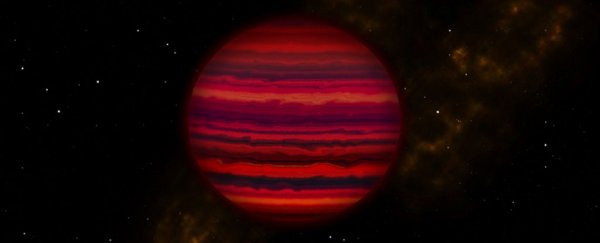Scientists have found strong evidence for the existence of water clouds on a nearby brown dwarf, and it's the first time these kinds of clouds have been discovered outside our Solar System.
The brown dwarf in question is called WISE 0855, and it's the coldest known object outside our Solar System. Not that we know that much about it yet, as it's extremely faint, but the findings could help us understand more about the composition of these extrasolar objects, as well as gas giants like Jupiter.
"We would expect an object that cold to have water clouds, and this is the best evidence that it does," said astronomer Andrew Skemer from the University of California, Santa Cruz.
WISE 0855 was discovered back in 2014, and is located just 7.2 light-years from Earth – relatively close to us, in astronomical terms.
It's neither a planet, nor a star. In fact, brown dwarfs are sometimes called 'failed stars' because they're somewhere between the two. They form in the same way stars do – from a gravitational conglomeration of gas and dust in space – but they don't have sufficient mass to spark or sustain the nuclear reactions in their cores that make stars shine.
What makes studying WISE 0855 so difficult is the fact that it's almost impossible for us to see using conventional spectroscopy. The brown dwarf's extreme faintness in the near-infrared spectrum, and the fact that it's many trillions of kilometres away, makes it barely visible to even some of our most powerful ground-based telescopes.
With persistence, Skemer and fellow researchers figured out how to obtain an infrared spectrum of WISE 0855, using the Gemini-North telescope in Hawaii, and recording a broader wavelength (at 5 microns) to that used in conventional spectroscopy at optical or near-infrared wavelengths (less than 2.5 microns).
"It's five times fainter than any other object detected with ground-based spectroscopy at this wavelength," said Skemer. "Now that we have a spectrum, we can really start thinking about what's going on in this object. Our spectrum shows that WISE 0855 is dominated by water vapour and clouds, with an overall appearance that is strikingly similar to Jupiter."
WISE 0855 has five times the mass of Jupiter, but isn't as cold, with a temperature of –23 degrees Celsius (–9 degrees Fahrenheit), compared to Jupiter's even frostier –143 degrees Celsius (–225 degrees Fahrenheit).
But despite the differences, the researchers think WISE 0855 and Jupiter are similar enough to help us learn more about these kinds of cold objects both in and outside our Solar System.
"WISE 0855 is our first opportunity to study an extrasolar planetary-mass object that is nearly as cold as our own gas giants," said Skemer.
Another difference between WISE 0855 and Jupiter is that the researchers think Jupiter has a more turbulent atmosphere. Jupiter's atmosphere contains a lot of the compound phosphine, which forms in the interior of the planet and goes on to create new chemical reactions in the outer atmosphere.
By contrast, WISE 0855 doesn't show a strong phosphine signal, which could mean it has less atmospheric reactions taking place. We won't know more until further observations of the brown dwarf are made, but what's exciting is that, thanks to the work done here, we now stand to learn a lot more about this cold, failed star, and the planets it resembles.
"The spectrum allows us to investigate dynamical and chemical properties that have long been studied in Jupiter's atmosphere, but this time on an extrasolar world," said Skemer.
The findings are to be published in The Astrophysical Journal Letters.
